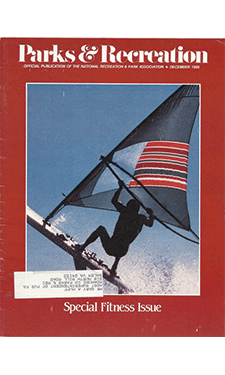 The December 1986 issue of Parks & Recreation magazine is akin to this month’s Health and Wellness Pillar. The “Special Fitness” issue illustrates the trends of the 1980s, with a focus on agencies that were proactive in the fitness movement. These “Agency Spotlights” served as examples of health and wellness programming at a time when declining general health and physical activity were capturing the park and recreation industry’s attention.
The December 1986 issue of Parks & Recreation magazine is akin to this month’s Health and Wellness Pillar. The “Special Fitness” issue illustrates the trends of the 1980s, with a focus on agencies that were proactive in the fitness movement. These “Agency Spotlights” served as examples of health and wellness programming at a time when declining general health and physical activity were capturing the park and recreation industry’s attention.
Editor Pamela Leigh sets the scene for readers in her editorial, “Fitness: The Antidote to an Ailing America,” writing, “In an age when labor-saving devices contribute to a sedentary lifestyle, western societies have discovered that ‘the good life,’ regrettably, is killing us. Obesity, heart ailments, lung cancer and other diseases are on a rise at a time when attention to the importance of fitness is gaining rapid attention. Recreation agencies are in a position to provide an antidote to these symptoms by offering programs and facilities to all Americans, rich or poor, old or young, able-bodied or not, who deserve an opportunity to improve or maintain their fitness levels…The recreation profession represents a ‘sleeping giant’ slowly awakening to its role in fulfilling the needs of people to be functionally fit (sweat equity) rather than just visually fit (halo effect).” Leigh continues on, writing of a materialistic society and the universal need to enrich the quality of life — words that still ring true almost 30 years later.
Leveraging Community Programming
Every day, professionals in our industry are developing innovative programming that encourages people from all walks of life to participate. In the article, “Senior Games, Getting Better with Age,” authors Beth Wilson and Margot Raynor describe a nonprofit created to motivate senior adults to get active. “North Carolina Senior Games (NCSG) is a year-round health and wellness promotion for adults 55 and older. In 1986, over 5,000 participants competed in 213 sanctioned local games, with the medal winners qualifying for the annual state finals,” they write. The games included more than 40 events for participants to choose from including basketball shooting, cycling, bowling and swimming. To this day and throughout the year, NCSG holds training classes for the events, fitness and wellness workshops, socials and other engaging activities for the adults. Today, NCSG is considered to be the largest health promotion organization of its type in the country with more than 60,000 participants in 53 local games programs that serve all 100 counties across the state.
The Cincinnati Recreation Commission’s (CRC) Healthline Fitness Course served as another example of what wellness programming could be. In the article, “Cincinnati’s Healthline Fitness Course Takes It to the Streets,” author Diann Viox describes the course thusly: “The fitness course contains easily identifiable walking and jogging routes and exercise clusters in open spaces along downtown sidewalks…The routes and activities vary in distance and intensity to meet an individual’s current fitness capacity and provide a challenge to improve performance.” The course was part of a program developed by Healthline to serve all 47 community neighborhoods in Cincinnati at that time, and target citizens and visitors alike. Three decades later, the number of esteemed promotions like these has grown exponentially as health and wellness remain at the forefront of recreational programming.
Catrina Belt is an Editorial Intern for Parks & Recreation magazine.

